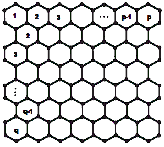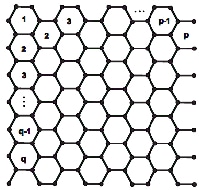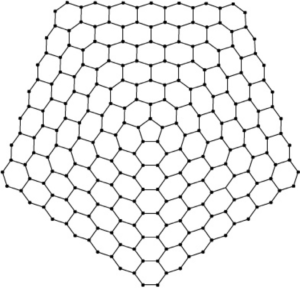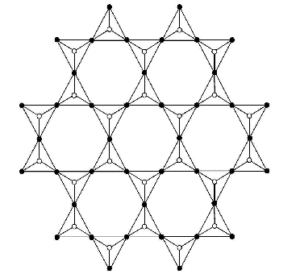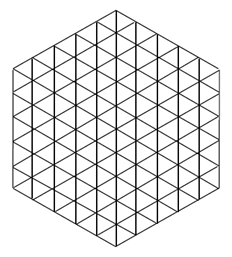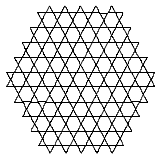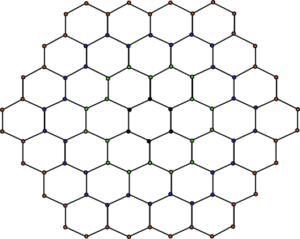Open Journal of Discrete Applied Mathematics
ISSN: 2617-9687 (Online) 2617-9679 (Print)
DOI: 10.30538/psrp-odam2019.0018
Computing multiplicative topological indices of some chemical nenotubes and networks
Department of Mathematics, Punjab College of Commerce New Campus Faisalabad Pakistan.; (Z.H)
Department of Mathematics, Government College University Faisalabad Pakistan.; (Z.H)
Superior Group of Colleges Faisalabad Campus, Faisalabad Pakistan.; (A)
Department of Applied Sciences, National Textile University Faisalabad Pakistan.; (S.H.A)
\(^{1}\)Corresponding Author: zaryabhussain2139@gmail.com; Tel.: +923207488346
Abstract
Keywords:
1. Introduction
Nowadays graph theory is one of the most ironic and cited branch of mathematics due to its direct applications in our daily life. It is widely used in Computer networking and Chemistry. The area of graph theory related to Chemistry known as Chemical graph theory. This term firstly introduced by Balaban in book [1] in 1976. After it in 1991, Bonchev discussed more concepts in book [2] and in the book [3] by Trinajstić, we found a facet ideas about chemical graph theory its uses and applications in our daily life.
In the recent few years, lot of work has been done in chemical graph theory like in [4], Ali et al. calculated the topological indices of some chemical compounds. Pattabiraman and Suganya in [5] and Kanabur in [6] calculated topological indices of some well known graphs. The concept of multiplicative topological indices of graphs was given in [7, 8, 9, 10]. In [11], Kahasy et al. calculate atom bond connectivity temperature index of some important organic compounds. Topological indices of some families of nanostar have been calculated in [12]. He and Jiang, in [13] calculated degree resistance distance of some trees. Degree-based multiplicative Atom-bond Connectivity index of some Nanostructures has been discussed [14]. In 2018, Hussain and Sabar [15] calculated multiplicative topological indices of single-walled titania nanotube. In [16], Kulli calculated some topological indices of two dimensional Silicate network, Chain silicate network, six dimensional Hexagonal network, five dimensional Oxide network and four dimensional Honeycomb network. Recently, Kulli [17] computed some topological indices of Zigzag polyhex nanotubes, Armchair polyhex nanotubes and Carbon nanocone networks. The main motivation of this work directly came from the papers [18, 19, 20].
2. Preliminaries
Let \(G\left(V\left(G\right),E\left(G\right)\right)\) be a finite, simple and connected graph with \(V\left(G\right)=\left\{v_{1}, v_{2}, \dots, v_{n}\right\}\) is the set of vertices and \(E\left(G\right)=\left\{e_{1}, e_{2}, \dots, e_{m}\right\}\) is the set of edges among the vertices of the graph. Consider a geodesic metric \(d_{G}: V\left(G\right)\times V\left(G\right)\rightarrow \mathbb{R}\) defined as \(d_{G}\left(u, v\right)\) is the number of edges between \(u\) and \(v\) in shortest path for any \(u, v \in V(G)\). All the vertices which are exactly at distance 1 from \(u\in V(G)\) are neighborhoods of \(u\) in graph \(G\) and collection of that vertices is called neighborhood set of \(u\) in graph \(G\) written as \(N_{G}\left(u\right)\). Cardinality of neighborhood set of \(u\in V(G)\) is called degree of \(u\) in graph \(G\) and in this paper it is denoted as \(\xi_{u}\).
First multiplicative Zagreb index is defined as:Fact 1. Let \(\eta_{1}, \eta_{2},\dots, \eta_{n}\) be a sequence. Then \begin{equation*} \prod\limits_{i=1}^{n}\left(\eta_{i}\right)^{\gamma}=\left(\prod\limits_{i=1}^{n} \eta_{i}\right)^{\gamma}, \end{equation*} where \(\gamma\) is a constant.
Proposition 2. Let \(G\left(V\left(G\right), E\left(G\right)\right)\) be any simple, connected and finite graph. Then \begin{equation*} SCII(G)=\left(II^{*}_{1}(G)\right)^{-\frac{1}{2}}. \end{equation*}
Proof. \begin{eqnarray*} SCII(G)&=&\prod_{rt\in E(G)}\frac{1}{\sqrt{\xi_{r}+\xi_{t}}}\\ &=&\left(\frac{1}{\sqrt{\xi_{r}+\xi_{t}}}\right)^{\left|E\left(G\right)\right|}\\ &=&\left(\xi_{r}+\xi_{t}\right)^{-\frac{\left|E\left(G\right)\right|}{2}}\\ &=&\left(\prod_{rt\in E(G)}\left(\xi_{r}+\xi_{t}\right)\right)^{-\frac{1}{2}}\\ &=&\left(II^{*}_{1}(G)\right)^{-\frac{1}{2}}. \end{eqnarray*}
Proposition 3. Let \(G\left(V\left(G\right), E\left(G\right)\right)\) be any simple, connected and finite graph. Then \begin{equation*} PCII(G)=\left(II_{2}(G)\right)^{-\frac{1}{2}}. \end{equation*}
Proof. \begin{eqnarray*} PCII(G)&=&\prod_{rt\in E(G)}\frac{1}{\sqrt{\xi_{r} \ . \ \xi_{t}}}\\ &=&\left(\frac{1}{\sqrt{\xi_{r} \ . \ \xi_{t}}}\right)^{\left|E\left(G\right)\right|}\\ &=&\left(\xi_{r} \ . \ \xi_{t}\right)^{-\frac{\left|E\left(G\right)\right|}{2}}\\ &=&\left(\prod_{rt\in E(G)}\left(\xi_{r} \ . \ \xi_{t}\right)\right)^{-\frac{1}{2}}\\ &=&\left(II_{2}(G)\right)^{-\frac{1}{2}}. \end{eqnarray*}
For detail concepts of topological indices on graphs we refer [10, 15].3. Main results
3.1. Zigzag Polyhex Nanotubes
Zigzag polyhex nantube is denoted as \(TUZC_{6}\left[p,q\right]\), where \(p\) is the number of hexagons in a row and \(q\) is the number of hexagons in a column.Figure 1. 2\(-\)Dimensional networks of \(TUZC_{6}\left[p,q\right]\)
Theorem 4. Let \(G\left(V\left(G\right), E\left(G\right)\right)\) be the graph of Zigzag polyhex nanotube \(TUZC_{6}\left[p,q\right]\). Then the first multiplicative Zagreb index for \(G\) is \(2^{p\left(3q-2\right)}\times 3^{p\left(3q-2\right)}\times 5^{4p}\).
Proof. The first multiplicative Zagreb index is: \begin{eqnarray*} II^{*}_{1}(G)&=&\prod\limits_{rt\in E(G)} \left(\xi_{r}+\xi_{t}\right)\\ &=& \prod\limits_{rt\in E_{1}(G)} \left(\xi_{r}+\xi_{t}\right)\times \prod\limits_{rt\in E_{2}(G)} \left(\xi_{r}+\xi_{t}\right)\\ &=&\left(2+3\right)^{\left|E_{1}(G)\right|}\times \left(3+3\right)^{\left|E_{2}(G)\right|}\\ &=&5^{4p}\times 2^{3pq-2p}\times 3^{3pq-2p}\\ &=&2^{p\left(3q-2\right)}\times 3^{p\left(3q-2\right)}\times 5^{4p}. \end{eqnarray*}
Theorem 5. Let \(G\left(V\left(G\right), E\left(G\right)\right)\) be the graph of Zigzag polyhex nanotube \(TUZC_{6}\left[p,q\right]\). Then the second multiplicative Zagreb index for \(G\) is \(2^{4p}\times 3^{6pq}\).
Proof. The second multiplicative Zagreb index is: \begin{eqnarray*} II_{2}(G)&=&\prod\limits_{rt\in E(G)} \left(\xi_{r} \ . \ \xi_{t}\right)\\ &=& \prod\limits_{rt\in E_{1}(G)} \left(\xi_{r} \ . \ \xi_{t}\right)\times \prod\limits_{rt\in E_{2}(G)} \left(\xi_{r} \ . \ \xi_{t}\right)\\ &=&\left(2 \ . \ 3\right)^{\left|E_{1}(G)\right|}\times \left(3 \ . \ 3\right)^{\left|E_{2}(G)\right|}\\ &=&2^{4p}\times 3^{4p}\times 3^{6pq-4p}\\ &=&2^{4p}\times 3^{6pq}. \end{eqnarray*}
Theorem 6. Let \(G\left(V\left(G\right), E\left(G\right)\right)\) be the graph of Zigzag polyhex nanotube \(TUZC_{6}\left[p,q\right]\). Then the multiplicative atomic bond connectivity index for \(G\) is \(2^{p\left(3q-4\right)}\times 3^{p\left(2-3q\right)}\).
Proof. The multiplicative atomic bond connectivity index is: \begin{eqnarray*} ABCII(G)&=&\prod_{rt\in E(G)}\sqrt{\frac{\xi_{r}+\xi_{t}-2}{\xi_{r} \ . \ \xi_{t}}}\\ &=& \prod_{rt\in E_{1}(G)}\sqrt{\frac{\xi_{r}+\xi_{t}-2}{\xi_{r} \ . \ \xi_{t}}}\times \prod_{rt\in E_{2}(G)}\sqrt{\frac{\xi_{r}+\xi_{t}-2}{\xi_{r} \ . \ \xi_{t}}}\end{eqnarray*}\begin{eqnarray*} &=&\left(\frac{2+3-2}{2 \ . \ 3}\right)^{\frac{\left|E_{1}\left(G\right)\right|}{2}}\times \left(\frac{3+3-2}{3 \ . \ 3}\right)^{\frac{\left|E_{2}\left(G\right)\right|}{2}}\\ &=&\left(\frac{1}{2}\right)^{2p}\times \left(\frac{2}{3}\right)^{p\left(3q-2\right)}\\ &=&2^{p\left(3q-4\right)}\times 3^{p\left(2-3q\right)}. \end{eqnarray*}
Theorem 7. Let \(G\left(V\left(G\right), E\left(G\right)\right)\) be the graph of Zigzag polyhex nanotube \(TUZC_{6}\left[p,q\right]\). Then the multiplicative geometric arithmetic index for \(G\) is \(2^{6p}\times 3^{2p}\times 5^{-4p}\).
Proof. The multiplicative geometric arithmetic index is: \begin{eqnarray*} G^{*}AII(G)&=&\prod_{rt\in E(G)}\left(\frac{2\sqrt{\xi_{r} \ . \ \xi_{t}}}{\xi_{r}+\xi_{t}}\right)\\ &=& \prod_{rt\in E_{1}(G)}\left(\frac{2\sqrt{\xi_{r} \ . \ \xi_{t}}}{\xi_{r}+\xi_{t}}\right)\times \prod_{rt\in E_{2}(G)}\left(\frac{2\sqrt{\xi_{r} \ . \ \xi_{t}}}{\xi_{r}+\xi_{t}}\right)\\ &=&\left(\frac{2\sqrt{2 \ . \ 3}}{2+3}\right)^{\left|E_{1}\left(G\right)\right|}\times \left(\frac{2\sqrt{3 \ . \ 3}}{3+3}\right)^{\left|E_{2}\left(G\right)\right|}\\ &=&\left(\frac{2 \ . \ 2^{\frac{1}{2}} \ . \ 3^{\frac{1}{2}}}{5}\right)^{4p}\times \left(\frac{2 \ . \ 3}{3+3}\right)^{2pq-2p} \\ &=&2^{6p}\times 3^{2p}\times 5^{-4p}. \end{eqnarray*}
3.2. Armchair Polyhex Nanotubes
Carbon polyhex nantubes are those nantubes in which the cylindrical surface is entirely made up of hexagons. These type of carbon nantubes have very interesting thermal, electrical and mechanical properties, actually these are very stabile in nature.Figure 2. 2\(-\)dimensional networks of \(TUAC_{6}\left[p, q\right]\)
Theorem 8. Let \(G\left(V\left(G\right), E\left(G\right)\right)\) be the graph of Armchair polyhex nanotube \(TUAC_{6}\left[p,q\right]\). Then the first multiplicative Zagreb index for \(G\) is \(2^{p\left(1+3q\right)}\times 3^{p\left(3q-1\right)}\times 5^{2p}\).
Theorem 9. Let \(G\left(V\left(G\right), E\left(G\right)\right)\) be the graph of Armchair polyhex nanotube \(TUAC_{6}\left[p,q\right]\). Then the second multiplicative Zagreb index for \(G\) is \(2^{4p}\times 3^{6pq}\).
Theorem 10. Let \(G\left(V\left(G\right), E\left(G\right)\right)\) be the graph of Armchair polyhex nanotube \(TUAC_{6}\left[p,q\right]\). Then the multiplicative atomic bond connectivity index for \(G\) is \(\sqrt{2^{p\left(6q-5\right)}}\times 3^{p\left(1-3q\right)}\).
Theorem 111. Let \(G\left(V\left(G\right), E\left(G\right)\right)\) be the graph of Armchair polyhex nanotube \(TUAC_{6}\left[p,q\right]\). Then the multiplicative geometric arithmetic index for \(G\) is \(2^{3p}\times 3^{p}\times 5^{-2p}\).
3.3. Carbon Nanocone Networks
An \(n-\)dimensional one\(-\)pentagone nanocone is denoted as \(CNC_{5}\left[n\right]\), where \(n\) is the number of hexagons layers encompassing the conical surface of nanocone and 5 denotes that there is a pentagon on the tip called its core.Figure 3. 6\(-\)dimensional one\(-\)pentagonal nanocone network
Theorem 12. Let \(G\left(V\left(G\right), E\left(G\right)\right)\) be the graph of Carbon nanocone networks \(CNC_{5}\left[n\right]\). Then the first multiplicative Zagreb index for \(G\) is \(\sqrt{2^{15n^{2}+5n+20}}\times \sqrt{3^{15n^{2}+5n}}\times 5^{10n}\).
Theorem 13. Let \(G\left(V\left(G\right), E\left(G\right)\right)\) be the graph of be the graph of Carbon nanocone networks \(CNC_{5}\left[n\right]\). Then the second multiplicative Zagreb index for \(G\) is \(2^{10\left(n+1\right)}\times 3^{15n\left(n+1\right)}\).
Theorem 14. Let \(G\left(V\left(G\right), E\left(G\right)\right)\) be the graph of Carbon nanocone networks \(CNC_{5}\left[n\right]\). Then the multiplicative atomic bond connectivity index for \(G\) is \(\sqrt{2^{5\left(3n^{2}-n-1\right)}}\times \sqrt{3^{-5n\left(3n+1\right)}}\).
Theorem 15. Let \(G\left(V\left(G\right), E\left(G\right)\right)\) be the graph of Carbon nanocone networks \(CNC_{5}\left[n\right]\). Then the multiplicative geometric arithmetic index for \(G\) is \(2^{15n}\times 3^{5n}\times 5^{-10n}\).
3.4. Silicate Networks
Silicates are formed by mixing of metal carbonates or metal oxides with sand. Silicate network is denoted as \(SL_{n}\), where \(n\) is the number of hexagons between the center and boundary of \(SL_{n}\).Figure 4. 2\(-\)dimensional silicate network
Theorem 16. Let \(G\left(V\left(G\right), E\left(G\right)\right)\) be the graph of Silicate network \(SL_{n}\). Then the first multiplicative Zagreb index for \(G\) is \(2^{18n\left(2n-1\right)}\times 3^{6n\left(9n+1\right)}\).
Theorem 17. Let \(G\left(V\left(G\right), E\left(G\right)\right)\) be the graph of Silicate network \(SL_{n}\). Then the second multiplicative Zagreb index for \(G\) is \(2^{18n\left(3n-1\right)}\times 3^{72n^{2}}\).
Theorem 18. Let \(G\left(V\left(G\right), E\left(G\right)\right)\) be the graph of Silicate network \(SL_{n}\). Then the multiplicative atomic bond connectivity index for \(G\) is \(2^{-9n\left(2n-1\right)}\times 3^{-36n^{2}}\times 5^{3n\left(3n-2\right)}\times 7^{3n\left(3n+1\right)}\).
Theorem 19. Let \(G\left(V\left(G\right), E\left(G\right)\right)\) be the graph of Silicate network \(SL_{n}\). Then the multiplicative geometric arithmetic index for \(G\) is \(2^{9n\left(3n+1\right)}\times 3^{-6n\left(3n+1\right)}\).
3.5. Chain Silicate Networks
Chain is obtained by arranging \(n\) tetrahedral linearly. Chain silicate networks are denoted as \(CS_{n}\).Figure 5. Chain silicate network
Theorem 20. Let \(G\left(V\left(G\right), E\left(G\right)\right)\) be the graph of Chain Silicate networks \(CS_{n}\). Then the first multiplicative Zagreb index for \(G\) is \(2^{3n}\times 3^{2\left(5n-1\right)}\).
Theorem 21. Let \(G\left(V\left(G\right), E\left(G\right)\right)\) be the graph of Chain Silicate networks \(CS_{n}\). Then the second multiplicative Zagreb index for \(G\) is \(2^{6\left(n-1\right)}\times 3^{12n}\).
Theorem 22. Let \(G\left(V\left(G\right), E\left(G\right)\right)\) be the graph of Chain Silicate networks \(CS_{n}\). Then the multiplicative atomic bond connectivity index for \(G\) is \(\sqrt{2^{-3n+12}}\times \sqrt{3^{-12n}}\times \sqrt{5^{n-2}}\times 7^{2n-1}\).
Theorem 23. Let \(G\left(V\left(G\right), E\left(G\right)\right)\) be the graph of Chain Silicate networks \(CS_{n}\). Then the multiplicative geometric arithmetic index for \(G\) is \(2^{3\left(2n-1\right)}\times 3^{-2\left(2n-1\right)}\).
3.6. Hexagonal Networks
It is known that there exist three regular plane tailings with composition of same kind of regular polygons such as triangles, squares and hexagonal. Triangular tiling is used in the construction of hexagonal networks. hexagonal network is denoted as \(HX_{n}\), where \(n\) is the number of vertices of in each side of hexagon.Figure 6. 6\(-\)diminsional hexagonal network
Theorem 24. Let \(G\left(V\left(G\right), E\left(G\right)\right)\) be the graph of Hexagonal Network \(HX_{n}\). Then the first multiplicative Zagreb index for \(G\) is \(2^{18\left(n^{2}-2n-1\right)}\times 3^{3\left(3n^{2}-11n+14\right)}\times 5^{12\left(n-2\right)}\times 7^{12}\).
Theorem 25. Let \(G\left(V\left(G\right), E\left(G\right)\right)\) be the graph of Hexagonal Network \(HX_{n}\). Then the second multiplicative Zagreb index for \(G\) is \(2^{6\left(3n^{2}-n-9\right)}\times 3^{6\left(3n^{2}-9n+10\right)}\).
Theorem 26. Let \(G\left(V\left(G\right), E\left(G\right)\right)\) be the graph of Hexagonal Network \(HX_{n}\). Then the multiplicative atomic bond connectivity index for \(G\) is \(\sqrt{2^{-3\left(3n^{2}-5n+2\right)}}\times 3^{-3\left(3n^{2}-10n+13\right)}\times \sqrt{5^{3\left(3n^{2}-11n+14\right)}}\times 7^{3}\).
Theorem 27. Let \(G\left(V\left(G\right), E\left(G\right)\right)\) be the graph of Hexagonal Network \(HX_{n}\). Then the multiplicative geometric arithmetic index for \(G\) is \(2^{3\left(6n-1\right)}\times 3^{6\left(n-2\right)}\times 5^{-12\left(n-2\right)}\times7^{-12}\).
3.7. Oxide Networks
An oxide network is denoted as \(OX_{n}\), where \(n\) is the number of dimensions.Figure 7. 5\(-\)diminsional oxide network
Theorem 28. Let \(G\left(V\left(G\right), E\left(G\right)\right)\) be the graph of Oxide Network \(OX_{n}\). Then the first multiplicative Zagreb index for \(G\) is \(2^{6n\left(9n-4\right)}\times 3^{12n}\).
Theorem 29. Let \(G\left(V\left(G\right), E\left(G\right)\right)\) be the graph of Oxide Network \(OX_{n}\). Then the second multiplicative Zagreb index for \(G\) is \(2^{12n\left(6n-1\right)}\).
Theorem 30. Let \(G\left(V\left(G\right), E\left(G\right)\right)\) be the graph of Oxide Network \(OX_{n}\). Then the multiplicative atomic bond connectivity index for \(G\) is \(2^{-3n\left(9n-4\right)}\times 3^{3n\left(3n-2\right)}\).
Theorem 31. Let \(G\left(V\left(G\right), E\left(G\right)\right)\) be the graph of Oxide Network \(OX_{n}\). Then the multiplicative geometric arithmetic index for \(G\) is \(2^{18n}\times 3^{-12n}\).
3.8. Honeycomb Networks
If we recursively use hexagonal tiling in a particular pattern, honeycomb networks are formed. A honeycomb is denoted as \(HC_{n}\), where \(n\) is the number of hexagons between the central and boundary hexagon.Figure 8. 4\(-\)diminsional honeycomb network
Theorem 32. Let \(G\left(V\left(G\right), E\left(G\right)\right)\) be the graph of Honeycomb Network \(HC_{n}\). Then the first multiplicative Zagreb index for \(G\) is \(2^{3\left(3n^{2}-5n+6\right)}\times 3^{3\left(3n^{2}-5n+2\right)}\times 5^{12\left(n-1\right)}\).
Theorem 33. Let \(G\left(V\left(G\right), E\left(G\right)\right)\) be the graph of Honeycomb Network \(HC_{n}\). Then the second multiplicative Zagreb index for \(G\) is \(2^{12n}\times 3^{18n\left(n-1\right)}\).
Theorem 34. Let \(G\left(V\left(G\right), E\left(G\right)\right)\) be the graph of Honeycomb Network \(HC_{n}\). Then the multiplicative atomic bond connectivity index for \(G\) is \(2^{3\left(3n^{2}-7n+3\right)}\times 3^{-3\left(3n^{2}-5n+2\right)}\).
Theorem 35. Let \(G\left(V\left(G\right), E\left(G\right)\right)\) be the graph of Honeycomb Network \(HC_{n}\). Then the multiplicative geometric arithmetic index for \(G\) is \(2^{18\left(n-1\right)}\times 3^{6\left(n-1\right)}\times 5^{-12\left(n-1\right)}\).
Remark 1. We can compute the following easily by using Propositions 2 and 3.
- i \(SCII\left(TUZC_{6}\left[p,q\right]\right)=2^{\frac{p\left(2-3q\right)}{2}}\times 3^{\frac{-p\left(2-3q\right)}{2}}\times 5^{-2p}\).
- ii \(PCII\left(TUZC_{6}\left[p,q\right]\right)=2^{-2p}\times 3^{-3pq}\).
- iii \(SCII\left(TUAC_{6}\left[p,q\right]\right)=\sqrt{2^{-p\left(1+3q\right)}}\times \sqrt{3^{-p\left(3q-1\right)}}\times 5^{-p}\).
- iv \(PCII\left(TUAC_{6}\left[p,q\right]\right)=2^{-2p}\times 3^{-3pq}\).
- v \(SCII\left(CNC_{5}\left[n\right]\right)=\sqrt[4]{2^{-5\left(3n^{2}+n+4\right)}}\times \sqrt[4]{3^{-5n\left(3n+1\right)}}\times 5^{-5n}\).
- vi \(PCII\left(CNC_{5}\left[n\right]\right)=2^{-5\left(n+1\right)}\times \sqrt{3^{-15n\left(n+1\right)}}\).
- vii \(SCII\left(SL_{n}\right)=2^{-9n\left(2n-1\right)}\times 3^{-3n\left(9n+1\right)}\).
- viii \(PCII\left(SL_{n}\right)=2^{-9n\left(3n-1\right)}\times 3^{-36n^{2}}\).
- ix \(SCII\left(CS_{n}\right)=\sqrt{2^{-3n}}\times 3^{-\left(5n-1\right)}\).
- x \(PCII\left(CS_{n}\right)=2^{-3\left(n-1\right)}\times 3^{-6n}\).
- xi \(SCII\left(HX_{n}\right)=2^{-9\left(n^{2}-2n-1\right)}\times \sqrt{3^{-3\left(3n^{2}-11n+14\right)}}\times 5^{-6\left(n-2\right)}\times 7^{-6}\).
- xii \(PCII\left(HX_{n}\right)=2^{-3\left(3n^{2}-n-9\right)}\times 3^{-3\left(3n^{2}-9n+10\right)}\).
- xiii \(SCII\left(OX_{n}\right)=2^{-3n\left(9n-4\right)}\times 3^{-6n}\).
- xiv \(PCII\left(OX_{n}\right)=2^{-6n\left(6n-1\right)}\).
- xv \(SCII\left(HC_{n}\right)=\sqrt{2^{-3\left(3n^{2}-5n+6\right)}}\times \sqrt{3^{-3\left(3n^{2}-5n+2\right)}}\times 5^{-6\left(n-1\right)}\).
- xvi \(PCII\left(HC_{n}\right)=2^{-6n}\times 3^{-9n\left(n-1\right)}\).
Remark 2. We can compute the following easily by using Fact 1.
- i \(HII_{1}\left(TUZC_{6}\left[p, q\right]\right)=2^{2p\left(3q-2\right)}\times 3^{2p\left(3q-2\right)}\times 5^{8p}\).
- ii \(HII_{2}\left(TUZC_{6}\left[p, q\right]\right)=2^{8p}\times 3^{12pq}\).
- iii \(MZ^{\alpha}_{1}\left(TUZC_{6}\left[p, q\right]\right)=2^{\alpha p\left(3q-2\right)}\times 3^{\alpha p\left(3q-2\right)}\times 5^{4\alpha p}\).
- iv \(MZ^{\alpha}_{2}\left(TUZC_{6}\left[p, q\right]\right)=2^{4\alpha p}\times 3^{6\alpha pq}\).
- v \(G^{*}A^{\alpha}II\left(TUZC_{6}\left[p, q\right]\right)=2^{6\alpha p}\times 3^{2\alpha p}\times 5^{-4\alpha p}\).
- vi \(HII_{1}\left(TUAC_{6}\left[p, q\right]\right)=2^{2p\left(1+3q\right)}\times 3^{2p\left(3q-1\right)}\times 5^{4p}\).
- vii \(HII_{2}\left(TUAC_{6}\left[p, q\right]\right)=2^{8p}\times 3^{12pq}\).
- viii \(MZ^{\alpha}_{1}\left(TUAC_{6}\left[p, q\right]\right)=2^{\alpha p\left(1+3q\right)}\times 3^{\alpha p\left(3q-1\right)}\times 5^{2\alpha p}\).
- ix \(MZ^{\alpha}_{2}\left(TUAC_{6}\left[p, q\right]\right)=2^{4\alpha p}\times 3^{6\alpha pq}\).
- x \(G^{*}A^{\alpha}II\left(TUAC_{6}\left[p, q\right]\right)=2^{3\alpha p}\times 3^{\alpha p}\times 5^{-2\alpha p}\).
- xi \(HII_{1}\left(CNC_{5}\left[n\right]\right)=2^{15n^{2}+5n+20}\times 3^{15n^{2}+5n}\times 5^{20n}\).
- xii \(HII_{2}\left(CNC_{5}\left[n\right]\right)=2^{20\left(n+1\right)}\times 3^{30n\left(n+1\right)}\).
- xiii \(MZ^{\alpha}_{1}\left(CNC_{5}\left[n\right]\right)=\sqrt{2^{\alpha\left(15n^{2}+5n+20\right)}}\times \sqrt{3^{\alpha\left(15n^{2}+5n\right)}}\times 5^{10\alpha n}\).
- xiv \(MZ^{\alpha}_{2}\left(CNC_{5}\left[n\right]\right)=2^{10\alpha \left(n+1\right)}\times 3^{15\alpha n\left(n+1\right)}\).
- xv \(G^{*}A^{\alpha}II\left(CNC_{5}\left[n\right]\right)= 2^{15\alpha n}\times 3^{5\alpha n}\times 5^{-10\alpha n}\).
- xvi \(HII_{1}\left(SL_{n}\right)=2^{36n\left(2n-1\right)}\times 3^{12n\left(9n+1\right)}\).
- xvii \(HII_{2}\left(SL_{n}\right)=2^{36n\left(3n-1\right)}\times 3^{144n^{2}}\).
- xviii \(MZ^{\alpha}_{1}\left(SL_{n}\right)=2^{18\alpha n\left(2n-1\right)}\times 3^{6n\alpha \left(9n+1\right)}\).
- xix \(MZ^{\alpha}_{2}\left(SL_{n}\right)=2^{18\alpha n\left(3n-1\right)}\times 3^{72\alpha n^{2}}\).
- xx \(G^{*}A^{\alpha}II\left(SL_{n}\right)= 2^{9\alpha n\left(3n+1\right)}\times 3^{-6\alpha n\left(3n+1\right)}\).
- xxi \(HII_{1}\left(CS_{n}\right)=2^{6n}\times 3^{4\left(5n-1\right)}\).
- xxii \(HII_{2}\left(CS_{n}\right)=2^{12\left(n-1\right)}\times 3^{24n}\).
- xxiii \(MZ^{\alpha}_{1}\left(CS_{n}\right)=2^{3\alpha n}\times 3^{2\alpha \left(5n-1\right)}\).
- xxiv \(MZ^{\alpha}_{2}\left(CS_{n}\right)=2^{6\alpha \left(n-1\right)}\times 3^{12\alpha n}\).
- xxv \(G^{*}A^{\alpha}II\left(CS_{n}\right)=2^{3\alpha \left(2n-1\right)}\times 3^{-2\alpha \left(2n-1\right)} \).
- xxvi \(HII_{1}\left(HX_{n}\right)=2^{36\left(n^{2}-2n-1\right)}\times 3^{6\left(3n^{2}-11n+14\right)}\times 5^{24\left(n-2\right)}\times 7^{24}\).
- xxvii \(HII_{2}\left(HX_{n}\right)=2^{12\left(3n^{2}-n-9\right)}\times 3^{12\left(3n^{2}-9n+10\right)}\).
- xxviii \(MZ^{\alpha}_{1}\left(HX_{n}\right)=2^{18\alpha \left(n^{2}-2n-1\right)}\times 3^{3\alpha \left(3n^{2}-11n+14\right)}\times 5^{12\alpha \left(n-2\right)}\times 7^{12\alpha}\).
- xxix \(MZ^{\alpha}_{2}\left(HX_{n}\right)=2^{6\alpha \left(3n^{2}-n-9\right)}\times 3^{6\alpha\left(3n^{2}-9n+10\right)}\).
- xxx \(G^{*}A^{\alpha}II\left(HX_{n}\right)=2^{3\alpha \left(6n-1\right)}\times 3^{6\alpha \left(n-2\right)}\times 5^{-12\alpha \left(n-2\right)}\times7^{-12\alpha } \).
- xxxi \(HII_{1}\left(OX_{n}\right)=2^{12n\left(9n-4\right)}\times 3^{24n}\).
- xxxii \(HII_{2}\left(OX_{n}\right)=2^{24n\left(6n-1\right)}\).
- xxxiii \(MZ^{\alpha}_{1}\left(OX_{n}\right)=2^{6\alpha n\left(9n-4\right)}\times 3^{12\alpha n}\).
- xxxiv \(MZ^{\alpha}_{2}\left(OX_{n}\right)=2^{12\alpha n\left(6n-1\right)}\).
- xxxv \(G^{*}A^{\alpha}II\left(OX_{n}\right)= 2^{18\alpha n}\times 3^{-12\alpha n}\).
- xxxvi \(HII_{1}\left(HC_{n}\right)=2^{6\left(3n^{2}-5n+6\right)}\times 3^{6\left(3n^{2}-5n+2\right)}\times 5^{24\left(n-1\right)}\).
- xxxvii \(HII_{2}\left(HC_{n}\right)=2^{24n}\times 3^{36n\left(n-1\right)}\).
- xxxviii \(MZ^{\alpha}_{1}\left(HC_{n}\right)=2^{3\alpha\left(3n^{2}-5n+6\right)}\times 3^{3\alpha\left(3n^{2}-5n+2\right)}\times 5^{12\alpha\left(n-1\right)}\).
- xxxix \(MZ^{\alpha}_{2}\left(HC_{n}\right)=2^{12\alpha n}\times 3^{18\alpha n\left(n-1\right)}\).
- xxxx \(G^{*}A^{\alpha}II\left(HC_{n}\right)=2^{18\alpha\left(n-1\right)}\times 3^{6\alpha \left(n-1\right)}\times 5^{-12\alpha\left(n-1\right)}\).
Author Contributions
All authors contributed equally to the writing of this paper. All authors read and approved the final manuscript.Conflicts of Interest:
The authors declare no conflict of interest.References
- Balaban, A. T. (1985). Applications of graph theory in chemistry. Journal of chemical information and computer sciences, 25(3), 334-343. [Google Scholor]
- Bonchev, D. (1991). Chemical graph theory: introduction and fundamentals (Vol. 1). CRC Press. [Google Scholor]
- Trinajstić, N. (2018). Chemical graph theory. Routledge. [Google Scholor]
- Ali, H., Baig, A. Q., & Shafiq, M. K. (2017). On topological properties of boron triangular sheet \(BTS(m, n)\), borophene chain \(B_{36}(n)\) and melem chain \(MC(n)\) nanostructures. Journal of Mathematical Nanoscience, 7(1), 39-60.[Google Scholor]
- Pattabiraman, K., & Suganya, T. (2018). Edge version of some degree based topological descriptors of graphs. Journal of Mathematical Nanoscienese, 8(1), 1-12. [Google Scholor]
- Kanabur, R. (2018). On certain cegree-based topological indices of armchair poly-hex nanotubes. Journal of Mathematical Nanoscienese, 8(1), 19-25. [Google Scholor]
- Gutman, I. (2011). Multiplicative Zagreb indices of trees. Bulletin of Society of Mathematicians Banja Luka, 18, 17-23. [Google Scholor]
- Iranmanesh, A., Hosseinzadeh, M. A., & Gutman, I. (2012). On multiplicative Zagreb indices of graphs. Iranian Journal of Mathematical Chemistry, 3(2), 145-154.[Google Scholor]
- Ghorbani, M., & Azimi, N. (2012). Note on multiple Zagreb indices. Iranian Journal of Mathematical Chemistry, 3(2), 137-143. [Google Scholor]
- Hussain, Z., Ijaz, N., Tahir, W., Butt, M. T., & Talib, S. (2018). Calculating Degree Based Multiplicative Topological indices of Alcohol. Asian Journal of Applied Science and Technology 4(2), 132-139. [Google Scholor]
- Kahasy, A.T., Narayankar, K., & Selvan, D. (2018). Atom bond connectivity temperature index. Journal of Mathematical Nanoscienese, 8(2), 67-75. [Google Scholor]
- Siddiqui, M. K., Rehman, N. A., & Imran, M. (2018). Topological indices of some families of nanostar dendrimers. Journal of Mathematical Nanoscienese, 8(2), 91-103. [Google Scholor]
- He, F. & Jiang, X. (2018). Degree resistance distance of trees with given perameters. Transaction on Combinatorics, 7(4), 11-24. [Google Scholor]
- Gao, W., Jamil, M. K., Nazeer, W., & Amin, M. (2017). Degree-Based Multiplicative Atom-bond Connectivity Index of Nanostructures. International Journal of Applied Mathematics, 47(4). [Google Scholor]
- Hussain, Z., & Sabar, S. (2018). On multiplicative degree based topological indices of single-walled titania nanotubes. Journal of Mathematical Nanoscienese, 8(1), 41-54.[Google Scholor]
- Kulli, V. R. (2017). Computation of some topological indices of certain networks. International Journal of Mathematical Archive, 8(2), 99-106.[Google Scholor]
- Kulli,V. R. (2019). F-Indices of chemical networks. International Journal of Mathematical Archivem, 10(3), 21-30. [Google Scholor]

